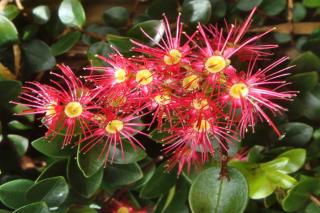

Beautiful with unique flowers, Metrosideros carmineus is an interesting summer shrub.
Key Metrosideros shrub facts
Name – M. carmineus, M. carminea
Family – Myrtaceae
Type – shrub
Height: 6 to 10 feet (2 to 3 m)
‘Ferris Wheel’ variety: 3 feet (1 m)
Exposure: full sun
Soil: ordinary – Foliage: evergreen – Flowering: end spring → mid-summer
It’s also nice during the rest of the year thanks to its evergreen foliage.
Planting recommended directly in the ground in spring in warm coastal climates.
Its hardiness isn’t very good: it won’t survive temperatures lower than 28°F (-2°C).
Elsewhere, best plant in containers so you can bring them in for winter.

It isn’t necessary to prune it, but you can go ahead and shape your Ferris wheel plant into a hedge or into topiary shapes.
Wait for the end of the blooming to balance out the branches so you don’t miss out on those surprising flowers!
This shrub offers remarkable blooming with its flowers that boast bright red stamens. It’s native to New Zealand, but is now quite easy to find in garden stores. It’s a close relative of common myrtle found natively in the Americas.
There are several varieties of interest: ‘Ferris Wheel’, ‘Carousel’, and ‘Red Baby’.
All are very ornamental and easy to care for. They’re perfectly suited to lean-ins or cold greenhouses.
Read also:
Keep the soil moist by watering often, but not too much when the soil is dry.
RE : Metrosideros Carmineus, Ferris wheel , you say it grows 6 to 10 feet (2 to 3 meters)? Other sites are saying it is a compact shrub variety of Metrosideros and only grows 1 Metre tall ? Is your info correct?
Hello Lisa, you’re right that the article was confusing. Practically, it’s about all Metrosideros carmineus shrubs, and the Ferris Wheel is the most famous variety. I rewrote the portions that were conflating the two. I hope it’s clearer now. Thanks a lot for your feedback, it’s very helpful.